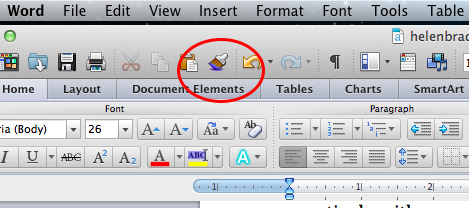

- #Microsoft word 2011 for mac table of contents how to#
- #Microsoft word 2011 for mac table of contents update#
If you formatted your headings with distinct styles for each level, but used styles other than the built-in heading styles, click the Options button in the Table of Contents dialog box to map the styles you used to the ToC framework. When inserting the ToC, choose Insert Table of Contents to specify formatting-including how tab leaders and page numbers are formatted, and which heading levels to include. Even in a shorter document, you might choose to only include Heading 1 and Heading 2 text in your ToC. The default Word ToC includes the first three heading levels you won’t want this much detail in ToCs for longer documents.

With your heading styles all applied, click on the References tab and insert your table of contents. Select all the second-level headings and apply the Heading 2 style, and so on. If the headings in your document aren’t formatted with styles, before inserting your table of contents, select each of the top-level headings for your ToC and apply the Heading 1 style from the Styles group on the Home tab of the ribbon.

When people reading your document on-screen hover over a page number, they’ll be reminded that they can use the ToC for navigation. Hold Ctrl and click on one of the page numbers to navigate to that location in the document. The ToC will include a string of dots called a leader between the heading text and the page number for each heading. Word will create a ToC from the document text you styled with one of the first three heading styles: Heading 1, Heading 2, and Heading 3. Automatic Table 2 creates a ToC titled Table of Contents. Automatic Table 1 creates a ToC titled Contents.
#Microsoft word 2011 for mac table of contents how to#
In this article I’ll show you how to create a table of contents (ToC) in Word 2013-but you’ll use the same process to create one in Word 2010, Word 2007 and Word 2011 for the Mac.
#Microsoft word 2011 for mac table of contents update#
They give printed documents a sophisticated look and feel, and add ebook-like navigation to onscreen documents.īut did you know that tables of contents are wicked easy to create and update in Microsoft Word? I created the following table of contents with just three clicks-and so can you. That is what makes them useful, not only to make the document easier to read once printed but also to navigate through it while editing it in Word.You already know that a table of contents makes it easier for your readers to work with long documents of 10 or more pages. Update the indexįinally, you should know that each entry in an index has a hyperlink. At that time, the new titles you have added will be displayed in the index. When you add a new section to the file, click on the table of contents and click on Update Table. Secondly, the indexes must be updated manually. The application will add each title according to its importance. Word will then know how to create an index automatically. You should use these formats to organize your document. Therefore, in the style section, you will see options such as Title, Title 1, Title 2, and so on. Word lets the user organize documents into hierarchies based on titles. However, there are a few things we should tell you about this feature.įirst of all, the indexes base their content on the titles. Index aspectĪt this point, you already know how to add an index to a Word document. The appearance of the index should look like the one you see in the following screenshot. Remember that you can subsequently change the format of the different elements of the index. Select the one you like best for your document. Word includes some predefined layouts that let the user add indexes quickly. There, you will find the option Table of contents.


 0 kommentar(er)
0 kommentar(er)
